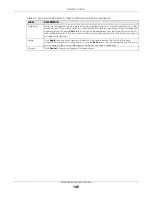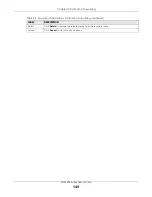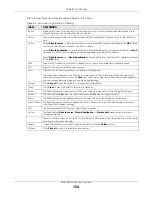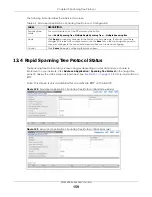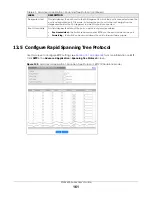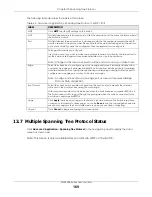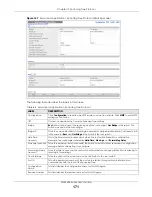
Chapter 13 Spanning Tree Protocol
XGS4600 Series User’s Guide
160
The following table describes the labels in this screen.
Table 60 Advanced Application > Spanning Tree Protocol
LABEL
DESCRIPTION
Bridge
Root
refers to the base of the spanning tree (the root bridge).
Our Bridge
is this Switch. This
Switch may also be the root bridge.
Bridge ID
This is the unique identifier for this bridge, consisting of bridge priority plus MAC address. This ID
is the same for
Root
and
Our Bridge
if the Switch is the root switch.
Hello Time
(second)
This is the time interval (in seconds) at which the root switch transmits a configuration
message. The root bridge determines
Hello Time
,
Max Age
and
Forwarding Delay
.
Max Age (second)
This is the maximum time (in seconds) the Switch can wait without receiving a configuration
message before attempting to reconfigure.
Forwarding Delay
(second)
This is the time (in seconds) the root switch will wait before changing states (that is, listening to
learning to forwarding).
Note: The listening state does NOT exist in RSTP.
Cost to Bridge
This is the path cost from the root port on this Switch to the root switch.
Port ID
This is the priority and number of the port on the Switch through which this Switch must
communicate with the root of the Spanning Tree.
Topology
Changed Times
This is the number of times the spanning tree has been reconfigured.
Time Since Last
Change
This is the time since the spanning tree was last reconfigured.
SLOT
This field appears only in stacking mode. Click the drop-down list to choose the slot number of
the Switch in a stack.
Port
This field displays the number of the port on the Switch. In stacking mode, the first number
represents the slot ID and the second is the port number.
Port State
This field displays the port state in STP.
•
Discarding
– The port does not forward or process received frames or learn MAC
addresses, but still listens for BPDUs.
•
Learning
– The port learns MAC addresses and processes BPDUs, but does NOT forward
frames yet.
•
Forwarding
– The port is operating normally. It learns MAC addresses, processes BPDUs
and forwards received frames.
Port Role
This field displays the role of the port in STP.
•
Root
– A forwarding port on a non-root bridge, which has the lowest path cost and is the
best port from the non-root bridge to the root bridge. A root bridge does NOT have a root
port.
•
Designated
– A forwarding port on the designated bridge for each connected LAN
segment. A designated bridge has the lowest path cost to the root bridge among the
bridges connected to the LAN segment. All the ports on a root bridge (root switch) are
designated ports.
•
Alternate
– A blocked port, which has a best alternate path to the root bridge. This path is
different from using the root port. The port moves to the forwarding state when the
designated port for the LAN segment fails.
•
Backup
– A blocked port, which has a backup or redundant path to a LAN segment
where a designated port is already connected when a switch has two links to the same
LAN segment.
•
Disabled
– Not strictly part of STP. The port can be disabled manually.
Designated Bridge
ID
This field displays the identifier of the designated bridge to which this port belongs when the
port is a designated port. Otherwise, it displays the identifier of the designated bridge for the
LAN segment to which this port is connected.
Designated Port ID
This field displays the priority and number of the bridge port (on the designated bridge),
through which the designated bridge transmits the stored configuration messages.

